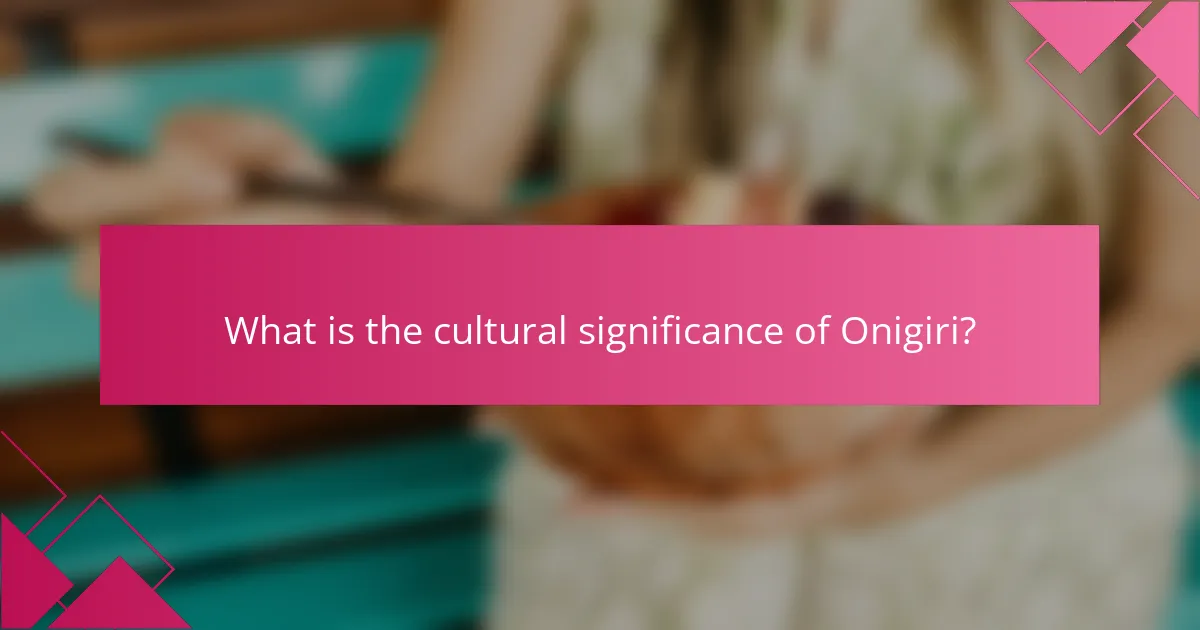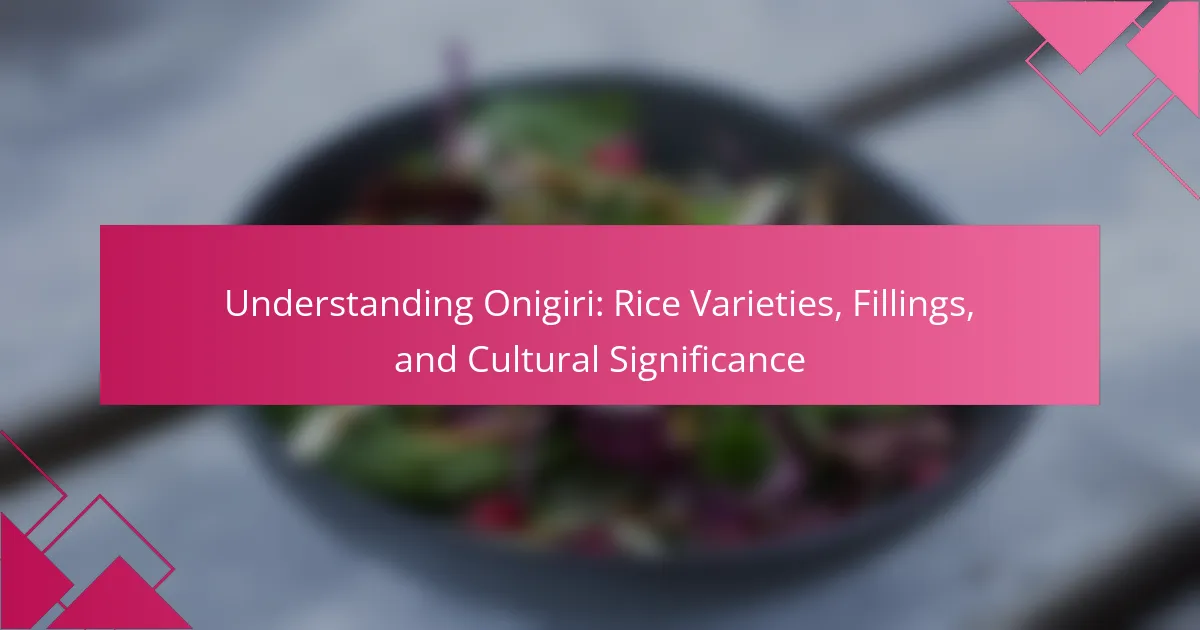
What is Onigiri?
Onigiri is a Japanese rice ball, typically shaped into a triangle or oval. It is made from cooked rice, often seasoned with salt. Onigiri is commonly filled with various ingredients, such as pickled plum, salmon, or seaweed. The rice used can vary, with short-grain varieties being most popular. Onigiri is a traditional food in Japan, often eaten as a snack or lunch. It is known for its portability and convenience. The history of onigiri dates back to the Heian period (794-1185). It remains a staple in Japanese cuisine today.
How is Onigiri traditionally made?
Onigiri is traditionally made by shaping cooked rice into triangular or cylindrical forms. First, short-grain Japanese rice is washed and soaked before cooking. The rice is then steamed or boiled until it becomes sticky. Once cooked, the rice is cooled slightly for easier handling. A small amount of filling, such as pickled plum or seaweed, is placed in the center. The rice is then molded around the filling using hands or a mold. Finally, onigiri is often wrapped in nori seaweed for added flavor and convenience. This method has been practiced in Japan for centuries, emphasizing the importance of rice in Japanese cuisine.
What are the essential ingredients for making Onigiri?
The essential ingredients for making Onigiri are rice, water, and fillings. Short-grain Japanese rice is typically used for its stickiness. Water is needed to cook the rice properly. Common fillings include umeboshi (pickled plum), salmon, or tuna. Nori (seaweed) is often used to wrap or garnish Onigiri. Each ingredient plays a crucial role in the texture and flavor of the dish.
What techniques are used in shaping Onigiri?
Onigiri is shaped primarily using three techniques: hand shaping, mold shaping, and using plastic wrap. Hand shaping involves forming the rice into a triangular or oval shape using the hands. This technique allows for personalization in size and shape. Mold shaping uses wooden or plastic molds to create uniform onigiri shapes. This method ensures consistency in size and presentation. Using plastic wrap involves placing rice in a sheet and forming it into shape before sealing. This technique prevents sticking and allows for easy handling. Each method contributes to the traditional presentation and enjoyment of onigiri.
What types of rice are used in Onigiri?
Short-grain rice is primarily used in Onigiri. This type of rice is sticky when cooked. The stickiness allows the rice to hold its shape. Japanese rice varieties such as Koshihikari and Sasanishiki are common choices. Koshihikari is known for its sweet flavor and firm texture. Sasanishiki offers a slightly less sticky quality. Both varieties are ideal for forming Onigiri. Their unique attributes enhance the overall eating experience.
How do different rice varieties affect the texture of Onigiri?
Different rice varieties significantly affect the texture of Onigiri. Short-grain rice, like Japonica, is sticky and holds shape well. This stickiness allows Onigiri to maintain its form during handling. Medium-grain rice provides a balance of stickiness and firmness. Long-grain rice, such as Basmati, results in a drier and less cohesive texture. This makes it less suitable for Onigiri. The starch content in rice varieties influences their texture. Japonica rice has higher amylopectin, contributing to its sticky nature. In contrast, Indica rice has more amylose, leading to a fluffier texture. Thus, the choice of rice variety is crucial for achieving the desired Onigiri texture.
What are the most popular rice types for Onigiri preparation?
The most popular rice types for Onigiri preparation are short-grain Japanese rice, specifically Japonica rice. This rice variety is sticky and has a high starch content. The stickiness allows Onigiri to hold its shape when molded. Japonica rice is favored for its texture and flavor, making it ideal for this dish. Other rice types, like medium-grain rice, can also be used, but they are less common. The quality of the rice significantly impacts the overall taste of Onigiri.
What fillings are commonly found in Onigiri?
Common fillings found in Onigiri include salmon, tuna, pickled plum, and seaweed. Salmon is often grilled or salted. Tuna is usually mixed with mayonnaise for added flavor. Pickled plum, known as umeboshi, provides a tangy taste. Seaweed, or nori, may be used as a wrapping or filling. Other fillings can include chicken, mackerel, and various vegetables. These fillings reflect traditional Japanese flavors and preferences. Onigiri fillings vary regionally, showcasing local ingredients and culinary practices.
What are the traditional fillings for Onigiri?
Traditional fillings for Onigiri include umeboshi, salmon, and tuna. Umeboshi is a pickled plum known for its sour flavor. Salmon is often grilled or salted for a savory taste. Tuna is typically mixed with mayonnaise for creaminess. These fillings have historical significance in Japanese cuisine. They enhance the flavor and nutritional value of the rice. Onigiri is often enjoyed as a portable meal or snack. These fillings reflect regional preferences and seasonal ingredients.
How do regional variations influence Onigiri fillings?
Regional variations significantly influence Onigiri fillings. Different regions in Japan utilize local ingredients and flavors. For instance, in Hokkaido, fillings often feature salmon or crab, reflecting the region’s seafood abundance. Meanwhile, in Kansai, pickled vegetables like umeboshi are common, showcasing local preservation methods. The influence of regional agriculture also plays a role. Areas known for specific crops may incorporate those into Onigiri, such as the use of taro in Okinawa. Cultural practices and festivals can further dictate filling choices, as certain ingredients may be favored during celebrations. These regional preferences create a diverse array of Onigiri fillings across Japan.

What is the cultural significance of Onigiri?
Onigiri holds significant cultural importance in Japan as a traditional food item. It symbolizes nourishment and home-cooked meals, often associated with family and comfort. Onigiri is commonly prepared for picnics, school lunches, and travel, reflecting its role in daily life. The shape of onigiri, typically triangular or oval, is practical for easy handling and consumption. Historically, onigiri has roots in ancient Japan, where it was used as a portable food source for travelers and soldiers. The use of various fillings and seasonings showcases regional diversity and culinary creativity. Onigiri also represents the concept of “mottainai,” emphasizing respect for food and minimizing waste. Overall, onigiri embodies cultural values of simplicity, practicality, and familial connection in Japanese society.
Why is Onigiri considered a staple in Japanese cuisine?
Onigiri is considered a staple in Japanese cuisine due to its historical significance and versatility. Originating from ancient Japan, onigiri served as portable meals for travelers and laborers. The simple ingredients of rice and fillings make it easy to prepare and customize. Onigiri can be made with various rice types, such as Japonica, enhancing its cultural relevance. Additionally, it is often shaped into triangles or balls, making it visually appealing and convenient to eat. Onigiri is commonly enjoyed in everyday meals, picnics, and festivals, further solidifying its status in Japanese culture. The combination of practicality, tradition, and flavor contributes to onigiri’s staple status in Japanese cuisine.
How does Onigiri reflect Japanese cultural values?
Onigiri reflects Japanese cultural values through its emphasis on simplicity, seasonality, and craftsmanship. This traditional rice ball is often made with just a few ingredients, showcasing the Japanese aesthetic of minimalism. The fillings, such as umeboshi or grilled salmon, highlight the importance of seasonal ingredients in Japanese cuisine. Onigiri is also often shaped by hand, symbolizing the value placed on craftsmanship and personal touch in food preparation. Additionally, it represents the concept of “omotenashi,” or hospitality, as it is commonly prepared for others, reflecting care and thoughtfulness. Historically, onigiri has been a portable meal for travelers, embodying the Japanese value of convenience and practicality in daily life.
What role does Onigiri play in Japanese festivals and traditions?
Onigiri serves as a significant food item in Japanese festivals and traditions. It is often prepared and shared during celebrations, symbolizing good fortune and community. In traditional festivals like Hanami, onigiri is commonly enjoyed during picnics under cherry blossoms. The rice balls are easy to transport and can be filled with various ingredients, making them versatile for different occasions. Additionally, onigiri is associated with Shinto rituals, where it is offered to deities as a form of respect and gratitude. This practice highlights its cultural importance in Japanese [censured] and heritage.
How has Onigiri evolved over time?
Onigiri has evolved significantly from its origins in Japan. Initially, onigiri was a practical food for warriors and travelers, made for convenience. Historically, it was shaped by hand and often wrapped in bamboo leaves. Over time, the introduction of nori seaweed became popular for wrapping onigiri. This change enhanced preservation and added flavor. In modern times, onigiri has diversified in fillings, including tuna, salmon, and pickled plum. Additionally, it has gained international recognition, leading to variations in other countries. Today, onigiri is not only a staple in Japanese cuisine but also a symbol of Japanese culture.
What modern variations of Onigiri exist today?
Modern variations of Onigiri include a variety of fillings and flavors. Common fillings are tuna mayo, salmon, and pickled plum. Additionally, some Onigiri feature unconventional ingredients like avocado or spicy tuna. There are also regional specialties, such as Ikura (salmon roe) in Hokkaido. Some variations incorporate different rice types, including brown rice or mixed grain. Moreover, Onigiri can be found in various shapes, such as triangles or balls. The use of seaweed wraps has evolved to include flavored or colored options. These modern adaptations reflect changing tastes and dietary preferences.
How has globalization influenced Onigiri’s popularity outside Japan?
Globalization has significantly increased Onigiri’s popularity outside Japan. The rise of international Japanese cuisine has introduced Onigiri to diverse audiences. Global food trends have embraced convenience and portability, aligning with Onigiri’s characteristics. Cultural exchange through travel and media has further popularized this dish. Social media platforms showcase Onigiri recipes and variations, enhancing its appeal. Additionally, the availability of ingredients has made it easier for people worldwide to make Onigiri at home. Restaurants outside Japan have incorporated Onigiri into their menus, attracting a broader customer base. This fusion of cultures has solidified Onigiri’s status as a global food phenomenon.

What are some tips for making the perfect Onigiri?
Use short-grain Japanese rice for the best onigiri. This type of rice becomes sticky when cooked, allowing it to hold its shape. Rinse the rice thoroughly before cooking to remove excess starch. Cook the rice with the right water-to-rice ratio, typically 1:1.1. Allow the rice to cool slightly before shaping. Wet your hands with water to prevent sticking while molding the rice. Shape the rice into triangles or balls, ensuring they are compact. For added flavor, sprinkle a bit of salt on the rice or mix in seasonings. Use fillings like pickled plum or grilled salmon for traditional flavors.
What common mistakes should be avoided when making Onigiri?
Using the wrong type of rice is a common mistake when making Onigiri. Short-grain Japanese rice is essential for the right texture. Overcooking the rice can lead to mushiness, making it difficult to shape. Not allowing the rice to cool slightly before handling can result in burns. Failing to wet hands before shaping can cause the rice to stick. Using too much filling can make the Onigiri fall apart. Not seasoning the rice adequately can lead to bland flavors. Lastly, neglecting to wrap the Onigiri properly can cause them to dry out.
How can one ensure the rice is cooked perfectly for Onigiri?
To ensure the rice is cooked perfectly for Onigiri, use short-grain Japanese rice. Rinse the rice until the water runs clear to remove excess starch. Soak the rinsed rice in water for at least 30 minutes. This soaking helps achieve the desired texture. Use a rice cooker or a pot with a tight-fitting lid for cooking. The typical water-to-rice ratio is 1.2:1. Cook the rice on low heat for about 18-20 minutes. After cooking, let the rice rest for 10-15 minutes to firm up. Fluff the rice gently with a rice paddle before shaping it into Onigiri.
What are some creative filling ideas for Onigiri?
Creative filling ideas for Onigiri include a variety of ingredients. Some popular options are pickled plum (umeboshi), which adds a tangy flavor. Another option is grilled salmon, providing a rich and savory taste. Spicy tuna mixed with mayonnaise offers a modern twist. For a vegetarian choice, avocado and sesame seeds create a creamy texture. Additionally, teriyaki chicken gives a sweet and savory profile. A mixture of wasabi and cucumber adds a refreshing crunch. Lastly, kimchi can provide a spicy kick. These fillings highlight the versatility of Onigiri and cater to diverse tastes.
Onigiri is a traditional Japanese rice ball, typically shaped into triangles or ovals, made from short-grain rice and often filled with ingredients like pickled plum, salmon, or seaweed. This article explores the essential ingredients and traditional techniques for making onigiri, including the impact of different rice varieties on texture and the significance of various fillings. Additionally, it examines the cultural importance of onigiri in Japan, its role in festivals, and how it has evolved over time, including modern variations influenced by globalization. The article also provides tips for making perfect onigiri and highlights common mistakes to avoid.
